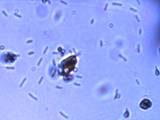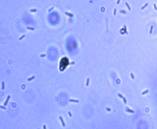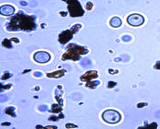About Us
Executive Editor:Publishing house "Academy of Natural History"
Editorial Board:
Asgarov S. (Azerbaijan), Alakbarov M. (Azerbaijan), Aliev Z. (Azerbaijan), Babayev N. (Uzbekistan), Chiladze G. (Georgia), Datskovsky I. (Israel), Garbuz I. (Moldova), Gleizer S. (Germany), Ershina A. (Kazakhstan), Kobzev D. (Switzerland), Kohl O. (Germany), Ktshanyan M. (Armenia), Lande D. (Ukraine), Ledvanov M. (Russia), Makats V. (Ukraine), Miletic L. (Serbia), Moskovkin V. (Ukraine), Murzagaliyeva A. (Kazakhstan), Novikov A. (Ukraine), Rahimov R. (Uzbekistan), Romanchuk A. (Ukraine), Shamshiev B. (Kyrgyzstan), Usheva M. (Bulgaria), Vasileva M. (Bulgar).
Last years a big attention in medical practice is given to phytogenesis enterosorbents to which are belong indigestible in small intestine not starched polysaccharides, such as cellulose, hemicelluloses, pectin, gum, slime and not carbohydrate lignine [1]. Vegetative sorbents are steady against action of enzymes of stomach and small intestine and are exposed to bacterial fermentation in a thick gut. Possibilities of fibers are connected with presence in their molecule hydroxyl and carboxyl groups causing their water-retaining, ion-exchanging and adsorptive properties. Among food fibers there are medical products (for example, polyphepan) and biologically active additives, such as zosterin, detoksal and polisorbit.
Enterosorbtion is based on known in physiology of digestion a phenomenon of maintenance of a constancy of the environment of the intestines which essence consists that irrespective of character of consumed food the chimes remains more or less constant. This constancy is provided by absorption into blood and lymph and excretion in a gleam of a gut of various components (water, electrolytes, carbohydrates, fats, etc.). In recirculation of blood components and chymus participate glands of gastrointestinal tract, liver, bile ducts and pancreas.
MATERIALS AND METHODS
As enterosorbent material in the given work has been used the activated coal and hydrolytic lignine, received on the basis of a waste of sanitary wood cuttings of saxaul. At preparation of enterosorbents, initial components were exposed to mechanical mixing in the ratio activated coal: lignine (100:0, 60:40, 50:50, 0:100) accordingly.
The purpose of the work was studying the efficiency of sorption of cells Salmonella typhimorium, Proteus vulgaris and Candida sp, obtained with the help of enterosorbent materials. Bacteria grew up in meat infusion broth, yeast in liquid medium Saburo at рН 7,0. Suspension for immobilization was prepared in an isotonic solution with density of cells 107 kl/ml. Sorption of cells was studied in a solution of chloride sodium in statistical conditions. Samples were selected in 24 hours of contact of sorbents with microorganisms and after upholding by duration 1 hour was defined number of cells. Number of cells in a liquid was defined by seeding of cultivations on the medium Endo or Saburo. Efficiency of sorption estimated on a difference of concentration of cells in cultural medium before and after sorption process. Ratio of the mass of sorbents was 1-3 gram on 100 ml of suspension. Sorbents preliminary were exposed to sterilization by autoclaving in duration of 30 mines at pressure 1,5atm. At desorption process sorbents with the cells, adsorbed on them, transferred to 100 ml of an isotonic solution, stirred up in duration of 5 minutes and sowed on Endo medium for definition cells titre [2-4].
Morph physiological characteristic of samples for a visual estimation of quantity of the attached cells of microorganisms to a surface of sorbents was investigated on microscope Leika MRS×1300.
RESULTS AND CONCLUSIONS
Enterobacterium and yeast-like mushrooms of sort Candida are a part of microbial association of intestines of the man. However at immunodisfunction of an organism or changing normal microbic cenosis can lead to disease development. It is possible to apply sorbents to correct micro flora of intestines of the person.
About immobilization intensity of the cells Salmonella typhimorium, Proteus vulgaris and Candida sp, judged by quantity of the attached cells in percentage from initial quantity of cells in the reactionary medium (table 1).
From the data presented in the table, it is visible that all studied sorbents-carriers effectively sorb bacterial cells, but on sorbents of type 50-50 and 60-40 sorption occurs more intensively for cells Salmonella typhimorium, than on sorbents of type 0-100 and 100-0. High efficiency of sorption of cells Proteus vulgaris and Candida sp is noted for sorbent 60-40 and has made 61,1 and 32,8 accordingly. The least number of sorption cells is characteristic for barmy cells in comparison with bacteria.
Efficiency of cells sorption of microorganisms directly depends on time of cultivation and the sorbent nature. Distinctions in degree of cells sorption have been confirmed by the data of light microscopy in the process of cultivation
(fig. 1-3).
The active attachment of cells on sorbents was observed after 6 hours of contact. The biggest quantity of sorption´s cells on sorbents-carriers of type 60-40 and 50-50 preserved since 10 hours of cultivation till 24 o´clock.


0 hours 24 hours
Salmonella typhimorium (sorbent 60-40)
Figure 1. Immobilization of culture Salmonella typhimorium on a surface of enterosorbents.


0 hours 24 hours
Proteus vulgaris (sorbent 60-40)
Figure 2. Immobilization of culture Proteus vulgaris on a surface of enterosorbents


0 hours 24 hours
Candida sp. (sorbent 60-40)
Figure 3. Immobilization of culture Candida sp on a surface of enterosorbents
Table 1. Efficiency of immobilization of the cells Escherichia coli, Salmonella typhimorium, Proteus vulgaris and Candida sp. on lignine containing sorbents
|
Sorbent types |
Cells quantity in suspension (108) |
Sorption activity, % |
Cells desorption, % |
|
Salmonella typhimorium |
|||
|
50-50 |
8,2 ±1,3 - 14,5±2,1 |
58,6±2,3 - 71,9±2,3 |
8,8±0,1 |
|
60-40 |
15,4 ±0,8 - 18,4±1,6 |
72,3±2,1 - 90,6±2,1 |
2,7±0,2 |
|
100-0 |
13,5 ±0,6 - 15,9±2,3 |
69,9±1,2 - 78,4±1,8 |
2,9±0,8 |
|
0-100 |
9,4±0,7 - 16,4±0,6 |
52,5±2,5 - 80,8±1,6 |
3,4±0,1 |
|
Proteus vulgaris |
|||
|
50-50 |
15,2 ±0,9 - 15,9±1,2 |
45,3±2,5 - 86,7±2,4 |
8,4±0,1 |
|
60-40 |
10,3 ±1,2 - 17,6±0,9 |
61,1±2,1 - 86,7±2,4 |
3,5±0,4 |
|
100-0 |
11,3 ±3,2 - 13,5±0,8 |
55,8±3,2 - 66,4±3,1 |
2,4±0,5 |
|
0-100 |
10,3 ±1,2 - 17,6±0,9 |
41,1±2,1 - 86,7±2,4 |
3,5±0,4 |
|
Candida sp. |
|||
|
50-50 |
15,3 ±1,4 - 17,9±1,4 |
28,3±1,7 - 88,6±1,4 |
6,7±0,5 |
|
60-40 |
14,7 ±1,8 - 16,1±0,5 |
32,8±1,8 - 78,4±1,2 |
5,7±0,2 |
|
100-0 |
11,3 ±3,2 - 13,5±0,8 |
24,8±3,2 - 66,4±3,1 |
7,4±0,5 |
|
0-100 |
10,3 ±2,1 - 15,3±0,7 |
30,8±2,2 - 75,4±1,4 |
8,8±0,2 |
According to presented the tabular data and drawings 1 - 3, for all species of microorganisms the best values of sorption are observed at use of a sorbent of type
60-40.
Thus, as a result of the done work it has been established that for enterbacteria: Salmonella typhimorium, Proteus vulgaris and Candida sp. the best indicators of sorption (32-72%) are observed at use of sorbent with a parity activated coal: lignine equal 60-40. Thereof, the received highly effective sorbents can be recommended for use at correction of bacterial micro flora.
REFERENCES
- Dudkin M.S., Shelkunov L.F. Using term "nutritional fibbers" and it classification. // Quest. of supply, 1998. - № 3. - P. 36-38.
- Abisheva A.K., Mansurova R.M., Ghubanova A.a., Mansurov Z.A. Studiying of sorption activity of adsorbents on the basis of carbonized shell of walnut // Herald KazGu , ecology series, 1999. - №1. - P. 18-20.
- Practical training session of biochemistry / by edition of S.E. Severin and G.A. Solovyeva, М.: Publ. МGU, 1989. - 509 p.
- Gergova K., Dimitrova L. Carbon sorbents - М., Mir,1994.- 102 p.
Yu. Shilina and M. Nauryzbaev SORPTION ACTIVITY RATING OF LIGNIN CONTAINING ENTEROSORBENTS AGAINST TO MICROORGANISMS OF INTESTINE. International Journal Of Applied And Fundamental Research. – 2010. – № 4 –
URL: www.science-sd.com/386-23437 (03.10.2025).











 PDF
PDF